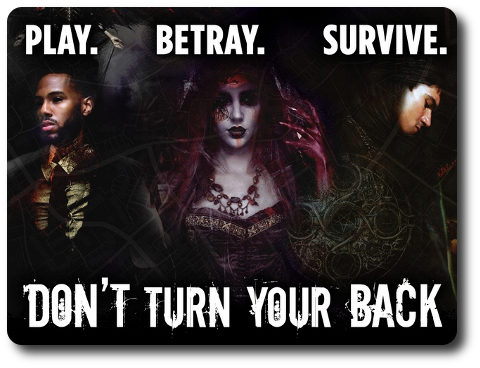
The Basics:
- For ages 8 and up (publisher suggests 13+)
- For 2 to 4 players
- Approximately 60 minutes to complete
Geek Skills:
- Counting & Math
- Logical & Critical Decision Making
- Reading
- Strategy & Tactics
- Risk vs. Reward
- Hand/Resource Management
- Worker Placement & Area Control
Learning Curve:
- Child – Moderate
- Adult – Easy
Theme & Narrative:
- Do you have what it takes to survive the Mad City?
Endorsements:
- Gamer Geek approved!
- Parent Geek mixed!
- Child Geek mixed!
Overview
You cannot sleep, and after suffering from insomnia, your mind starts to play tricks on you. Or perhaps you finally woke up? You are now trapped in the Mad City, where nightmares walk cobbled streets and you are hunted. This is a world of constant danger and deception. You must find the way home before someone else beats you to it.
Don’t Turn Your Back, designed by Eric B. Vogel and published by Evil Hat Productions, is comprised of 1 City board, 1 Candle Tally board, 4 Player boards (in 4 different colors), 4 Candle Tally markers (in 4 different colors), and 130 cards. The game component quality is excellent, but the real story here is the game’s artwork. Artists George Cotronis and Fred Hicks provide the players with gritty and dark visuals that are familiar, yet strangely alien. The game’s thematic background is best described as a “modern-day Gothic nightmare”, and the artists have done an outstanding job visually capturing that which lurks only in our subconscious mind.
Time to Wake Up
To set up the game, first place the City board in the middle of the game playing area. The City board contains spaces where players will place their cards, so make sure every player can easily reach it.
Second, separate the District 13 Law cards from the rest of the cards and find the “First Admonishment” District 13 Law card. Place this card aside and then shuffle the remaining District 13 Law cards. Then deal 7 cards to the Law space in the District 13 area of the City board, face-down, or 8 cards for a 3 player game. Place the “First Admonishment” District 13 Law card on top and face-up. Players should not look at the cards that were dealt or the cards that still remain. Place any District 13 Law cards not used back in the game box.
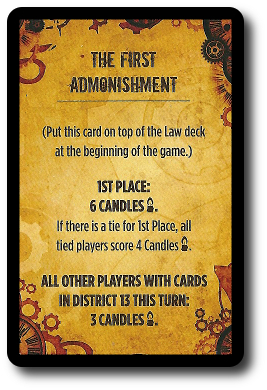
Pay attention to the rules…
Third, give each player 1 Player board, 1 starting deck of Favor cards, an Acquisition deck, and a Candle Tally marker. All components should be the same color. The Candle Tally markers are placed on the “Start” space of the Candle Tally board.
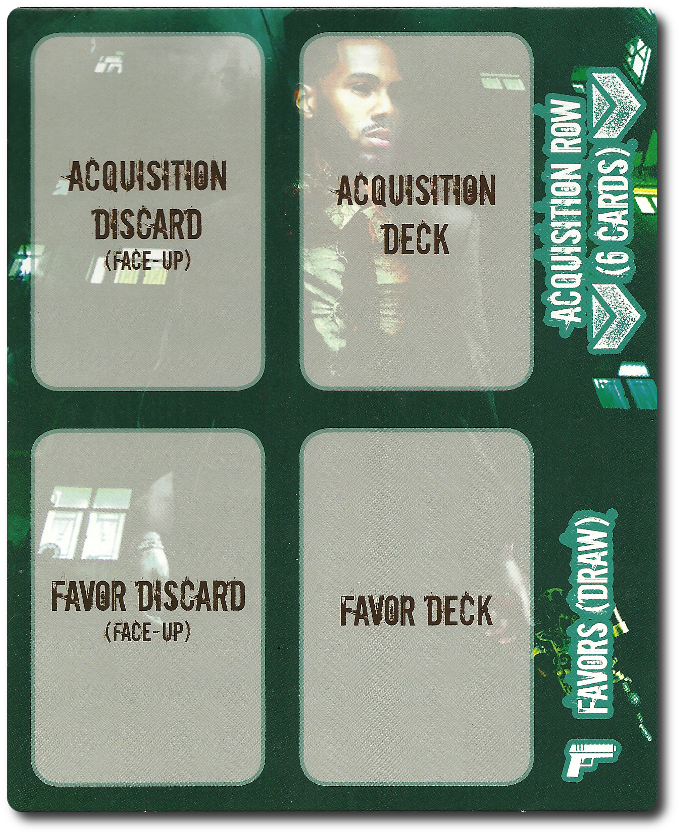
On the back of each Player board is the background story of the characters. Read it.
Fourth, each player now looks through their cards and sets aside any that have the term “START” in the upper right corner.
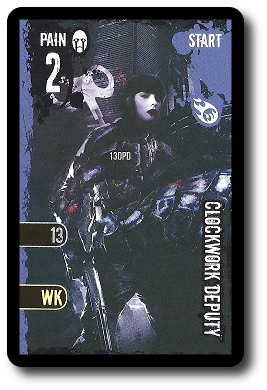
Fifth, each player now shuffles their Acquisition cards and places the deck face-down in the reserved space on their Player board. Then they draw the first 6 Acquisition cards, placing them face-up in a row next to the Acquisition draw deck.
Sixth, each player shuffles their starting cards and places them face-down to form their Favor deck. There is a spot reserved for the Favor deck on their Player board.
Seventh, each player now draws the first 4 cards from their Favor deck, creating the player’s starting hand.
That’s it for game set up. Determine who should go first and begin.
Know Your Nightmares
Each player in the game has the same number and type of cards; identical in every way except for their color. Each card represents a nightmare (a denizen of the Mad city) or a specific favor one of those creatures performs for the player. Understanding how each card can be used is crucial to building an efficient deck and escaping the Mad City.
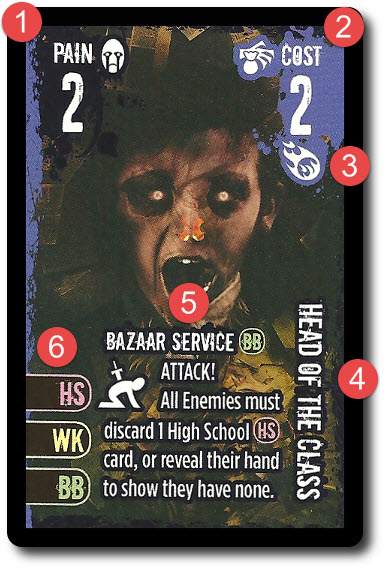
1) Pain Value: Pain is used to gain influence and to maintain dominance in Districts.
2) Cost Value: Nightmares are enterprising entities who are willing to join the player (become a playable card) if the price can be paid.
3) Player Icon: Useful for those who cannot see colors easily, these icons are on every card in the game, identifying who owns what.
4) Card Title: The names and titles of those who live in the Mad City are as mad as the city itself.
5) Bazaar Services: Play the card in the Bizarre Bazaar District and gain access to the ability listed on the card.
6) Allowed Districts: Cards can only be played to the Districts listed.
Some cards can attack others and some cards can defend against attacks. Some effects are not triggered until later in the game. These are particularly difficult to play because the player must think ahead. A common theme throughout the game is taking a risk. Do you take the shortcut for a temporary gain or do you take the long road that might lead to nowhere or to everywhere?
Welcome to the Mad City
Don’t Turn Your Back is played in turns, phases, and rounds. A single game consists of 8 (or 9 if playing with 3 players) total turns and each phase will have the players perform a number of actions by way of rounds of card plays. A single turn is summarized here.
Phase 1: Play Cards
Starting with the first player, each player will play 1 card from their hand to the City board. Cards can only be placed in certain Districts (as indicated on the card itself) and only to an open spot within that District. A number of cards can be placed in more than 1 District, which forces the player to consider how they want to use the card. Additionally, a number of cards will have different effects based on which District they are placed. If a District does not have a free space, then no additional cards can be placed to it.
This phase continues until all players have played their cards, are unable to play their cards, or have passed. If a player passes, they cannot play any additional cards during this phase.
Districts are more than just spots on the game board. They use different values on the cards and influence the game and endgame in unique ways. Each of the Districts are summarized here.
District 13
District 13 is controlled chaos. Each turn introduces a new Law that dictates bonuses and penalties. Loopholes are often in abundance, but so are the many pitfalls. District 13 is a place of ever-shifting values and rules that can be exploited if the player’s timing is right.
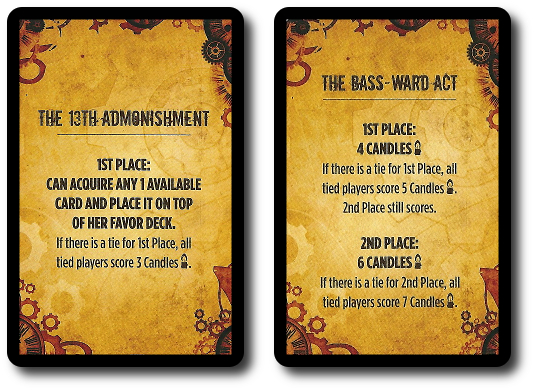
Every turn of the game means a new Law to follow
High School
Run by Mother When, a creature many consider to be an incarnation of Death, this place of education teaches harsh lessons. This District uses a card’s Pain value, but also it’s position in the District to determine when a card is removed from the City board. Placing a card here at the right time could greatly benefit a player due to the card remaining in play long after it has left the player’s hand.
The Wax Kingdom
Here the ruler of the land of nightmares and dreams sits upon his throne surrounded by those who have both pleased and disappointed him. The Wax King is one to fear, but also a potential ally if the player is crafty enough. This District is also one of the hardest to play to as the benefits to be gained only occur at the end of the game and there is always a chance that a player’s plans might backfire.
The Bizarre Bazaar
Anything and everything you can think of can be purchased and sold here. In game terms, this District is open to any card, but take caution. The Bizarre Bazaar welcomes all with great enthusiasm, making it very popular. A player who hesitates too long to visit will quickly find themselves locked out.
The City Slumbering
This is a space very close to our own where nightmares roam to collect the dreams of sleepers. Players can venture here to gather the painful memories of others and then sell them to to the denizens of the Mad City. Why do such a horrid thing? In the Mad City, pain is everything. If a player is able to collect enough influence, they can tap others to assist them in their work and use pain as means of trade, as we will soon see.
Phase 2: Acquire Influence
This phase allows the players to gather influence based on a card’s Pain value and convert it to a Cost value. Cost is used to purchase goods and services in the Mad City. Cards played by the player in the City Slumbering District convert their Pain value to Cost. The total Cost earned is then given to the player to spend if they want to purchase cards in their Acquisition row. The cost of a card is noted in the upper right corner. Some cards played in the Bizarre Bazaar will also provide Cost.
Acquired cards are placed face-up in the player’s Favor discard pile. Cards represent not only nightmares that dwell in the Mad City, but the favor they owe the player. As soon as a card is purchased, a new card is drawn and placed face-up to the Acquisition row.
This phase can be done in turn order sequence or all players can resolve their acquisitions simultaneously.
Phase 3: Score
The players now determine their score, recording it using the Candle Tally board.
Score the High School
The player with the highest Pain total in the High School District scores 1 Candle for each point of Pain on their own cards in the District. All other players earn 1 Candle for every card they played to the High School District.
Then count the number of cards for the player with the most cards played in the High School District again and remove that number of cards from the High School District, starting from the left-most end (the “Start” space). These cards have “graduated” and are returned to their owning players where they are placed in the Favor discard pile. All remaining cards in the High School District are shifted to the left to fill in the now empty gaps and will remain in play to be scored during the next turn.
Score District 13
The current Law card determines the conditions that must be met to earn Candles. Review the Law card and then determine which players score points, if any. Players should have been playing to this Law card to a certain degree during the turn if they wanted to earn any points from District 13. There are also penalties for players, so paying attention to this District is oftentimes exceedingly important.
Once the scores have been calculated and recorded for District 13, discard the current Law card and draw the next one. Every player should pause a moment to read the new Law, as it immediately goes into effect.
Phase 4: Clean Up and Draw Cards
While this is the last phase of the turn that primarily focuses on resetting the game, the players still have some important decisions to make.
Curry Favor from the Wax King
Players can now place cards to the Wax Kingdom, face-down, in hopes that they will win the Wax King’s support. Cards are placed face-down so players do not know how much Pain is being offered to the Wax King by their opponents. Cards played here are out for the duration of the game, allowing players to get ride of cards they no longer want or need. While not beneficial to the player now, these cards might help them win the game by providing bonuses. This is a great way to get rid of the “Start” cards to make room for more beneficial cards acquired during the game.
Close the Bizarre Bazaar
Players now gather their cards from the Bizarre Bazaar and place them in their Favor discard pile. These cards hopefully served their purpose and may yet return to the market of nightmares and dreams later in the game.
Draw New Cards
If the player has any cards in their hand, they may elect to keep them for the next turn of game play or discard them now. Then they draw back up to 4 cards. If their draw deck is empty, they shuffle their Favor discard pile to form their new draw deck.
The Starting Player card now passes to the next player in turn order sequence and a new turn begins.
Escaping the Mad City
The game continues until the 8th turn is completed (or 9th turn if playing a 3-player game). There is 1 District 13 Law card per turn in the game. Looking at how many cards are left should help the players determine how close they are to the end of the game, giving them time to change their tactics if needed.
Players now collect all their cards except those in the Wax Kingdom and remove any “Start” cards they still have. “Start” cards provide no bonuses or points.
Then players collect the cards they placed in the Encased pile in the Wax Kingdom District. The total Pain values are tallied for each player who contributed to the Encased pile.
Points are now earned based on the cards in the player’s hand. All “Start” cards and cards placed in the Encased pile in the Wax Kingdom District are not counted at this time.
- The player with the highest total Pain in the Wax Kingdom District scores 1 Candle for every point of Cost noted on their cards in their deck.
- The player with the second highest total Pain in the Wax Kingdom District scores 1 Candle for every point of Pain noted on their cards in their deck.
- The player with the third highest total Pain in the Wax Kingdom District scores 2 Candles for every card in their deck.
- The player with the fourth highest total Pain in the Wax Kingdom District scores 1 Candle for every card in their deck.
After the points have been calculated and the Candle Tally board updated, the player with the most Candles wins and is allowed to return to our world. The other players must remain in the Mad City forever.
To learn more about Don’t Turn Your Back, visit the game’s web page.
Final Word
The Child Geeks were first drawn to the game’s illustrations. We reviewed this game in the month of October and all things Halloween and ghoulish are the coolest at the moment. The Child Geeks were a bit disappointed to see that all the cards were the same (as in all the players had the same cards), but they very much enjoyed what they saw. Their level of enthusiasm dwindled when we started playing the game. The younger Child Geeks had difficulty keeping up with all the cards they were collecting and what their significance was to the endgame. According to one of these Child Geeks, “I really like the cards, but I don’t really understand why one is better than another.” The older and more experienced Child Geeks were already familiar with deck-building games and quickly grasped the game’s most basic concepts. Their decks were not that well-built to begin with, but that is exactly what you’d expect to see from new players. After several games, the Child Geeks were doing much better. According to one of these older Child Geeks, “The game is not that hard to learn, but the cards can be used lots of different ways which makes it tricky to know what to do at first.” When all those that could escaped the Mad City did, the Child Geeks gave Don’t Turn Your Back a mixed level of approval.
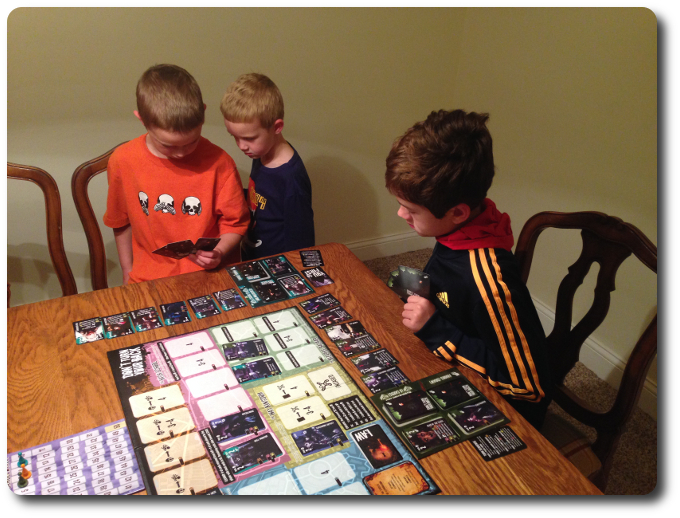
When it came time to acquire new cards, every Child Geek first took the coolest looking ones
The Parent Geeks were almost the exact opposite. What they were first drawn to was the game’s deck-building and worker placement mechanics. What they didn’t care for were the illustrations. According to one Parent Geek, “Gads! The images on some of these cards are the stuff of nightmares!” To which I told her they were nightmares, which didn’t seem to help matters any. The Parent Geeks were also not too fond of the theme, or the lack thereof. According to one rather vocal Parent Geek, “If you are going to go to the trouble of providing players a lot of visually interesting cards, they should have at least explained the story better and made it part of the game.” The rule book does contain something of a backstory, but not a lot of detail is provide overall. Game play wise, the Parent Geeks were happy with what they saw. A few of the Parent Geeks thought the deck-building was a bit clunky, but they couldn’t put into words their reasons. The end result was a mixed level of approval from the Parent Geeks, which was surprising, as I observed the majority of this group having a good time.
The Gamer Geeks found the game visually interesting, but ultimate borderline themeless. According to one Gamer Geek, “Some outstanding artwork, but all of the gloom is just pasted on.” Which many of the Gamer Geeks found to be disappointing, but not overly significant. To them, the game was the most important aspect and they very much enjoyed it. As one Gamer Geek put it, “Some really interesting things going on in this game. I’m digging how the cards work, the decks are built, and the way players can set cards aside for the final scoring. I’m very impressed.” Another Gamer Geek said, “Super smooth game play. The cards are interesting and the multiple ways they can be used is even more interesting. I’d play this again without hesitation.” All the Gamer Geeks agreed that Don’t Turn Your Back was a game they would never turn away from.
This is a solid game. It combines deck-building (that I love) with worker placement (that I love) that provides variable effects based on card placement and timing (which I love). So, yeah, I love the game. It plays exceedingly well, with each turn and round effortlessly moving from one phase to the next. There is bit of a hurdle when you first learn, as new cards are introduced and players attempt to connect the dots, but it never took any of our players long to get comfortable and enjoy themselves. While I cannot say the game’s theme overly impressed or interested me, I really enjoyed the game’s depth of play, the strategy I was able to explore, and the many tactical ways I could use the cards. Each game left me happy and interested in trying something new the next time I played it.
The game’s theme won’t appeal to some, but the bright spot here is that the game’s theme doesn’t have much to do with anything. It’s there, on the surface, providing visual interest and terminology, but that’s about it. Any theme could be placed on top to replace it without much effort. While I would not go so far as to say that Don’t Turn Your Back is “themeless”, I would say it’s “theme pointless”. It doesn’t add much value and caused a bit of confusion as players attempted to answer the question: Just what am I looking at here?
For those who do want to learn more about the world the game is set in, a book is available that contains short shorties from the Mad City. Don’t Read This Book follows the brave and the foolish as they try to navigate the twisting paths of the Mad City and its politics. These are not the kind of stories you read to your kids before bedtime, but it does bring the game to life. Now you’ll know who and what these cards represent and their importance to the character. Unfortunately, the book does not come with the game, but nor is it required to play.
Theme aside, or even included in the conversation, Don’t Turn Your Back is a fun and engaging game. It’s like an oddly dressed, but really interesting person. Once you get past the individual’s eccentricities, you realize there is something of genuine value worth getting to know. And you really should get to know this game.
This game was given to Father Geek as a review copy. Father Geek was not paid, bribed, wined, dined, or threatened in vain hopes of influencing this review. Such is the statuesque and legendary integrity of Father Geek.



